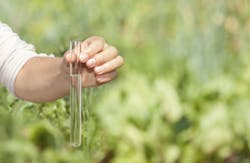Coming soon in the October issue of Water Technology, Marianne Metzger of Certified National Analytics (CNA) Environmental writes about collecting water samples. In this article, Metzger explains the importance of following the right steps when gathering samples while taking into consideration factors such as the location, conditions and the desired sampling method.
Preparing for sample collection
To ensure the best results, it is important to properly collect the samples. Before starting the collection process determine if the samples need to meet regulatory requirements, and if so, check to see if the set regulations specify which sampling method must be performed.
You should plan ahead before collecting samples, keeping in mind bottle type, desired sample method and collection location.
“The methods that will be flowed will determine the type of bottles used,” explains Metzger. “For example, samples for metals analyses are usually collected in plastic bottles, while analyses for volatile organics and pesticides are collected in glass containers. The size of the container is important to ensure you have enough sample to run the analysis needed.” Metzger adds that container size can be affected by regulation, noting that larger samples may be needed to obtain lower detection levels.
When you are ready to choose the right method, you must determine where you will collect the samples. Remember that the objective of the water analysis will affect the location. Except in cases concerning a specific water quality issue, collecting samples from the kitchen sink is recommended.
Once the location is established you should collect a representative water sample. You can measure the pH, temperature and conductivity every two to three minutes while collecting three consistent measurements in a row to determine if you have allowed efficient water flow.
Documenting sample information
In order for the laboratory to verify the samples are run within the correct holding times, recording information such as the date and time collected is essential. Metzger explains that it is important to also include identification to help compare results year to year.
She adds, “When submitting samples to a lab, a chain of custody form will need to accompany the sample to indicate what analysis needs to be run, the date and time collected, sample identification and who assembled the sample.”
To learn more about procedures to follow when collecting water samples be sure to check out Water Technology’s October issue.
In the August issue of Water Technology, Marianne Metzger wrote an article on choosing the right testing methods. You can find that article here.
See below for additional related content:
